The Philippines are officially going into my books as one of the most beautiful countries I’ve visited, at least as far as breathtaking scenes per square kilometer go, they’re plentiful. The spectacular combination of mountains and water is everywhere and as I might have mentioned a few times, I am truly a sucker for this kind of scenery.
Braslavschina - The most amazing place you’ve never heard of
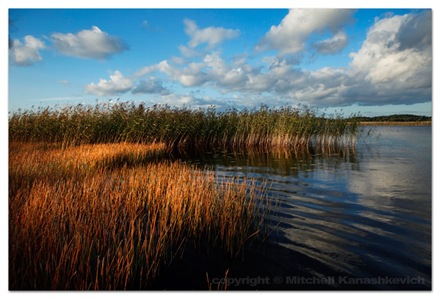 I have just returned from Braslavschina – the region around the town of Braslav and as I mentioned in my last post, all of my expectations have been surpassed. There are plenty of old, traditional villages, wonderful, photogenic people and there are over 400 lakes – almost all of them ridiculously picturesque.
I have just returned from Braslavschina – the region around the town of Braslav and as I mentioned in my last post, all of my expectations have been surpassed. There are plenty of old, traditional villages, wonderful, photogenic people and there are over 400 lakes – almost all of them ridiculously picturesque.
Perhaps it’s some sub-conscious thing about this region being a part of my “motherland”, but Braslavschina has quickly become one of my favorite places in the world. All I need to be happy is – something to photograph, some place to swim and some nice people to chat to. :) I can find all of that here, plus the kind of nature, which I only thought existed in fairy tales.
Ok, so I’ve fallen in love with this place, I really mean it. I’ve even enquired about prices of land and simple houses here and I have found out that they are ridiculously cheap, at least by Western standards. If I find something suitable, I’ll soon have my own tiny piece of paradise, perhaps even one right on a lake.
Anyway, enough dreaming. Here’s a brief look at what I’ve seen so far. I’m in Minsk for a few days to sort out some paperwork on my newly bought ‘84 Volskwagen Golf II. It ain’t pretty, but it’s cheap, it’ll take me where I want and it’s mine. I’ll be coming back to Braslavschina as soon as I can. I’ve only scratched the surface, as far as photography goes.
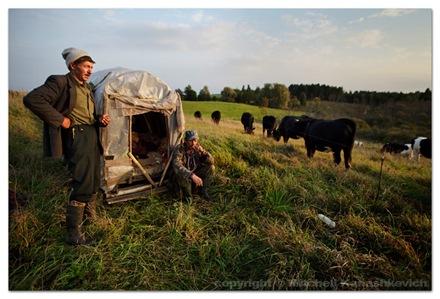 Tolik and Vatsik – two cow herders taking a break. It seems like I’ve got this strange attraction to cattle herders and fishermen, wherever I go. More on fishermen in the near future.
Tolik and Vatsik – two cow herders taking a break. It seems like I’ve got this strange attraction to cattle herders and fishermen, wherever I go. More on fishermen in the near future.
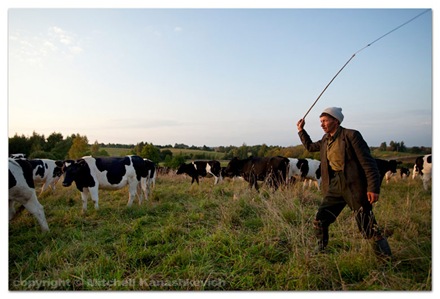 Tolik herding cows with a whip.
Tolik herding cows with a whip.
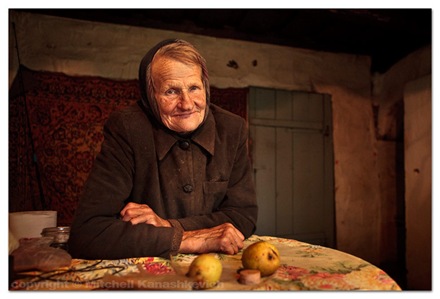 Above and below are images of kind elderly ladies from two different villages with the same story. In the really traditional villages there isn’t much youth these days and the old are the living, walking, breathing embodiment of the incredible history of this area.
Above and below are images of kind elderly ladies from two different villages with the same story. In the really traditional villages there isn’t much youth these days and the old are the living, walking, breathing embodiment of the incredible history of this area.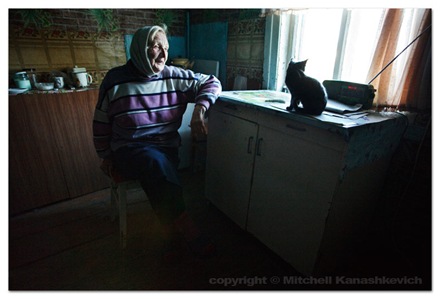
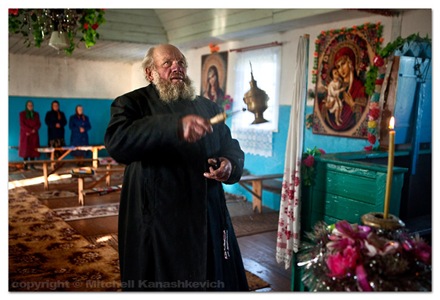 A prayer inside a church of the “Old Russian Orthodox” faith. It’s very similar to the “standard” Russian Orthodox religion, but all the prayer’s are written in ancient Russian and read accordingly. Only two people in this village can read them – this “Father” is one of them. The “Old Russian Orthodox” faith is almost extinct in Belarus. The three ladies in the background are basically the only attendees.
A prayer inside a church of the “Old Russian Orthodox” faith. It’s very similar to the “standard” Russian Orthodox religion, but all the prayer’s are written in ancient Russian and read accordingly. Only two people in this village can read them – this “Father” is one of them. The “Old Russian Orthodox” faith is almost extinct in Belarus. The three ladies in the background are basically the only attendees.
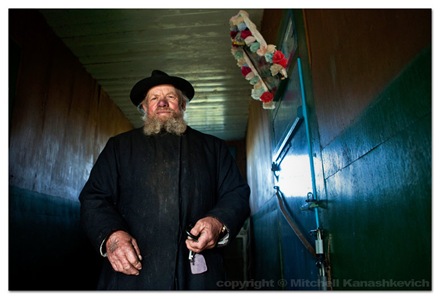 Father Akim (a very unusual name for Belarus) on his way out of the church.
Father Akim (a very unusual name for Belarus) on his way out of the church.
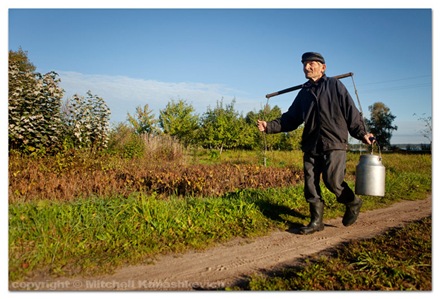 Every morning this man waits by the side of the road to sell is milk to large government-run co-operatives. Here he is returning home after selling the milk.
Every morning this man waits by the side of the road to sell is milk to large government-run co-operatives. Here he is returning home after selling the milk.
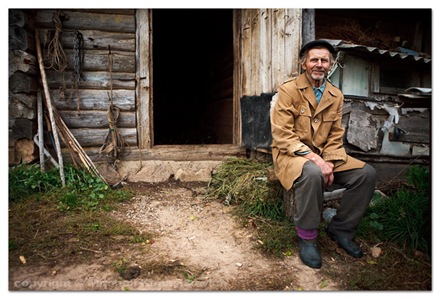 Grandpa Alexei was very shy about being photographed. When it comes to photos initial shyness is a common reaction amongst most of the older people. They’ll usually say something along these lines – “Why would you want to photograph me? I’m not shaven” or “I haven’t even got my teeth”. To me however these faces are amazing, they say so much without the need for words. After a short chat and me explaining what I do everyone usually agrees to have their picture taken.
Grandpa Alexei was very shy about being photographed. When it comes to photos initial shyness is a common reaction amongst most of the older people. They’ll usually say something along these lines – “Why would you want to photograph me? I’m not shaven” or “I haven’t even got my teeth”. To me however these faces are amazing, they say so much without the need for words. After a short chat and me explaining what I do everyone usually agrees to have their picture taken.
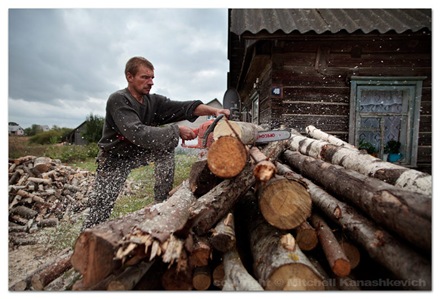 The modern way of preparing firewood – with a chainsaw. The man – Vasily is one the few younger men choosing to live his life in the countryside. He does however work outside of his village, on construction sites in cities as large and as far as Moscow.
The modern way of preparing firewood – with a chainsaw. The man – Vasily is one the few younger men choosing to live his life in the countryside. He does however work outside of his village, on construction sites in cities as large and as far as Moscow.
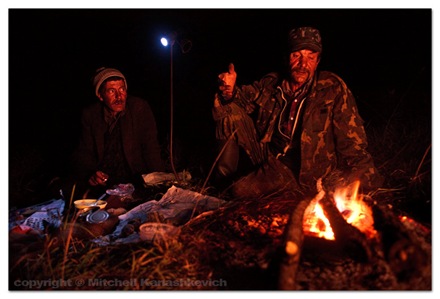 Back to the cow herders – Tolik and Vatsik having their dinner by the fire. I won’t mention what they were drinking.
Back to the cow herders – Tolik and Vatsik having their dinner by the fire. I won’t mention what they were drinking.
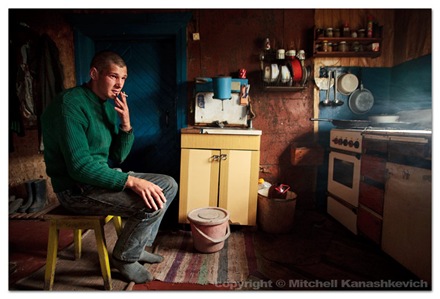 Vova is another rare find, he is the only young man in his village. The rest have moved out and now live and work in Belarus’ larger cities. Photographically speaking this is the sort of portrait I am enjoying shooting more and more these days - a shot where the person is surrounded by objects that tell you something about his her life/culture.
Vova is another rare find, he is the only young man in his village. The rest have moved out and now live and work in Belarus’ larger cities. Photographically speaking this is the sort of portrait I am enjoying shooting more and more these days - a shot where the person is surrounded by objects that tell you something about his her life/culture.
Ok, that’s all for now. Needless to say, I can’t wait to go back and shoot some more stuff. I have also filmed some interviews and some scenes that are best communicated through “moving pictures”, but unfortunately my ancient laptop isn’t powerful enough to edit HD video. Well, I guess that’ll all have to wait.
Incredible India!
 Vythiri, Wayanad - As we took our seats in the little restaurant the waiter brought out two glasses of water; he held the glasses from the inside so that his fingers were completely immersed in the water that we were meant to drink. When I was a child we used to have two types of juice served at the school canteen. Everyone liked only one flavor and so whoever would get to it first would dip his finger into the juice glass and proclaim - "This one' s mine! I dipped my finger into it!" None of the children would drink the juice which was probed with someone else's finger...I guess that mightn't be the case here.The fingers in the glass of water are a common sight in local restaurants all over India. It's such a small thing, but it always reminds me that the world which I come from is so different to this country that keeps luring me in with something new every time. It also reminds me that from our "Western" point of view there are so many of these little things which India just "doesn't get" and this is somewhat puzzling because regarding some of the bigger issues India has so much to teach the countries that "get" the little things.
Vythiri, Wayanad - As we took our seats in the little restaurant the waiter brought out two glasses of water; he held the glasses from the inside so that his fingers were completely immersed in the water that we were meant to drink. When I was a child we used to have two types of juice served at the school canteen. Everyone liked only one flavor and so whoever would get to it first would dip his finger into the juice glass and proclaim - "This one' s mine! I dipped my finger into it!" None of the children would drink the juice which was probed with someone else's finger...I guess that mightn't be the case here.The fingers in the glass of water are a common sight in local restaurants all over India. It's such a small thing, but it always reminds me that the world which I come from is so different to this country that keeps luring me in with something new every time. It also reminds me that from our "Western" point of view there are so many of these little things which India just "doesn't get" and this is somewhat puzzling because regarding some of the bigger issues India has so much to teach the countries that "get" the little things.
 The things that India doesn't "get" are numerous. They often surprise, even shock first time visitors, but usually they become somewhat funny, once they are long gone and exist only in the back of one's mind, as stories to tell friends.
The things that India doesn't "get" are numerous. They often surprise, even shock first time visitors, but usually they become somewhat funny, once they are long gone and exist only in the back of one's mind, as stories to tell friends.
Here are some of these little things: - An omelet-maker scratching his crotch then serving you the omelet with the same hand. - A cleaner in a fancy restaurant sweeping the rubbish near you while you eat, forcing you to lift your feet as he sweeps under your table. - Sitting on the train looking lost with an empty plastic water bottle and a local saying "Give it to me please", taking it and tossing it out the window. - A devotee at a temple reading religious texts into a microphone and occasionally coughing, snorting and spitting up phlegm while the sound is magnified to the full capacity of the speakers. - VERY loud wedding processions. Loud means the sound from the speakers on the street will make your hotel room on the third floor vibrate like the inside of a night-club on a Friday night, oh and all the fun happens regardless of what time it is, meaning that the vibrations will occasionally get you up in the middle of the night.
 These are light-hearted examples, but occasionally there are those things that make you cringe long after they happen. I still remember how shocked I was, when for the first time I saw a youngster at Haridwar (a holy Hindu town) push a huge pile of rubbish into the Ganges - the holiest river for Hindus around India. Later I learned that it's normal here. Every picnic spot, every waterfall, beach and lake is polluted with wrappers, plastic bottles and whatever else. It mightn't be as bad as the industrial waste of some "first world countries" but close to a billion people throwing crap wherever they please can't be good for the environment, and it's just damn unpleasant. Am I criticizing the same people of India which I love? In some way "Yes", but I'm not doing it to say that "We" are better. Far from it. It's not like Indian general public don't have any idea about personal hygiene. Normally people don't even eat breakfast before showering and brushing their teeth, while most dwellings, these even include some that I've visited in the slums are spotless clean. I figure that teaching children not to throw rubbish into a river should be a much easier task than the one the "West" should undertake - teaching children to care for each other the way so many people in India do. I like to be naive and imagine that one day we'll all "GET IT" and the world will be one big, happy place :). My cynical side though, tells me that the day is still not even within sight.
These are light-hearted examples, but occasionally there are those things that make you cringe long after they happen. I still remember how shocked I was, when for the first time I saw a youngster at Haridwar (a holy Hindu town) push a huge pile of rubbish into the Ganges - the holiest river for Hindus around India. Later I learned that it's normal here. Every picnic spot, every waterfall, beach and lake is polluted with wrappers, plastic bottles and whatever else. It mightn't be as bad as the industrial waste of some "first world countries" but close to a billion people throwing crap wherever they please can't be good for the environment, and it's just damn unpleasant. Am I criticizing the same people of India which I love? In some way "Yes", but I'm not doing it to say that "We" are better. Far from it. It's not like Indian general public don't have any idea about personal hygiene. Normally people don't even eat breakfast before showering and brushing their teeth, while most dwellings, these even include some that I've visited in the slums are spotless clean. I figure that teaching children not to throw rubbish into a river should be a much easier task than the one the "West" should undertake - teaching children to care for each other the way so many people in India do. I like to be naive and imagine that one day we'll all "GET IT" and the world will be one big, happy place :). My cynical side though, tells me that the day is still not even within sight.
 Anyhow, I've been influenced by my experiences over the past few days. Perhaps all of the things that one becomes used to in "Indian India" became more apparent after our stay at Bylakuppe - "Tibetan India". Bylakuppe is not crowded, it's not loud and there are signs everywhere warning people not to litter. The signs are not always obeyed, but at least their presence means that there is some awareness. Our hotel room in Bylakuppe was spacious and quiet and had a view of a beautiful green garden from its window. This made our stay in the crammed room with "wall views" in Mysore that much more painful. But the most painful part came at night. Around 1am we were woken up by the sound of a TV at near full blast. Just as the noise died down and I began to doze off I was woken up again, this time by the sound of the "service buzzer" - an extremely annoying invention used to bring a hotel worker to your room. The problem with the service buzzer is that it makes a buzz so loud, the whole hotel hears it and hears it well. The room service however, only comes after the irritating sound is repeated several times. On this night the buzzer was pressed without any desire for room service - it was located near the bed and a hotel guest had simply pressed it in his sleep. The buzzing continued for about two minutes. Maybe I woke up the guilty party with my swearing in Russian (to make it less offensive :)) as I walked around the corridor trying to figure out where the buzz was coming from, in any case, thankfully the noise stopped.
Anyhow, I've been influenced by my experiences over the past few days. Perhaps all of the things that one becomes used to in "Indian India" became more apparent after our stay at Bylakuppe - "Tibetan India". Bylakuppe is not crowded, it's not loud and there are signs everywhere warning people not to litter. The signs are not always obeyed, but at least their presence means that there is some awareness. Our hotel room in Bylakuppe was spacious and quiet and had a view of a beautiful green garden from its window. This made our stay in the crammed room with "wall views" in Mysore that much more painful. But the most painful part came at night. Around 1am we were woken up by the sound of a TV at near full blast. Just as the noise died down and I began to doze off I was woken up again, this time by the sound of the "service buzzer" - an extremely annoying invention used to bring a hotel worker to your room. The problem with the service buzzer is that it makes a buzz so loud, the whole hotel hears it and hears it well. The room service however, only comes after the irritating sound is repeated several times. On this night the buzzer was pressed without any desire for room service - it was located near the bed and a hotel guest had simply pressed it in his sleep. The buzzing continued for about two minutes. Maybe I woke up the guilty party with my swearing in Russian (to make it less offensive :)) as I walked around the corridor trying to figure out where the buzz was coming from, in any case, thankfully the noise stopped.
 It's possible that this "wonderful" night contributed to us not wanting to stay in Mysore the next day, but more likely it was the fact that Mysore didn't offer us anything new. The fatigue of constantly moving around is catching up to us and we desperately wanted some peace and quiet, as well as something interesting to photograph :). Too much to ask for in India, sometimes, but after bouncing around a few towns in the breathtakingly beautiful Wayanad district we found what we wanted - a little YMCA hostel with a few private rooms, located amidst some spectacular tea plantations - my photographic subject for the next few days. Wayanad is not all perfect though, thanks to the hordes of mostly local tourists that do the things I previously mentioned make me cringe - eat, pollute and crap all over Wayanad's star attractions - the Pookote Lake, Soochipara Waterfalls and many more places. Thankfully we've had the peace and quiet we craved, I photographed what I wanted and now, rejuvenised, we're ready to continue our way to the most Southern point of India - Kanyakumari. Trissur, considered Kerala's cultural capital will be our next stop.
It's possible that this "wonderful" night contributed to us not wanting to stay in Mysore the next day, but more likely it was the fact that Mysore didn't offer us anything new. The fatigue of constantly moving around is catching up to us and we desperately wanted some peace and quiet, as well as something interesting to photograph :). Too much to ask for in India, sometimes, but after bouncing around a few towns in the breathtakingly beautiful Wayanad district we found what we wanted - a little YMCA hostel with a few private rooms, located amidst some spectacular tea plantations - my photographic subject for the next few days. Wayanad is not all perfect though, thanks to the hordes of mostly local tourists that do the things I previously mentioned make me cringe - eat, pollute and crap all over Wayanad's star attractions - the Pookote Lake, Soochipara Waterfalls and many more places. Thankfully we've had the peace and quiet we craved, I photographed what I wanted and now, rejuvenised, we're ready to continue our way to the most Southern point of India - Kanyakumari. Trissur, considered Kerala's cultural capital will be our next stop.
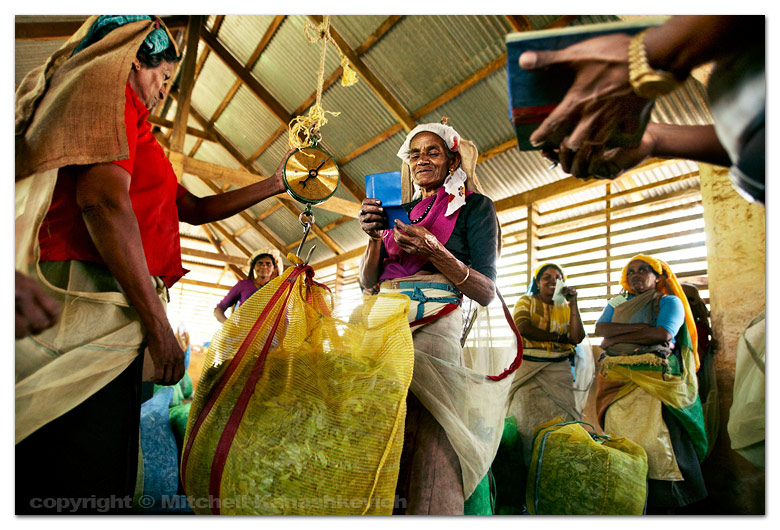 Photos
I mostly photographed at one tea plantation, which was located not far from the place where I stayed. Coming back and photographing in the same place is beneficial because not only do you become familiar with the location, but the people you are photographing also become more familiar with you. The people at this particular plantation were absolutely wonderful. They were childlike in the way they became excited when they saw two foreigners enter their world, which I imagine for them is rather mundane. All eyes were on us. A smile would be met with a huge grin and shy laughter. In the distance we could hear the workers quietly telling each other what to say - '"What is your name?" "What is your native place?" and then someone would work up enough courage to ask the questions out loud. Our answers would be met with even more excited laughter and commotion. It seemed as if the workers were saying to each other "It worked! They understood us!". Taking a photograph of the women usually led to the women cracking up with shy laughter, while those that were outside of the photo would joke and say "Smile please!", until I would point the camera at them and they'd also crack up. Photographing at this tea plantation was one of those beautiful, simple, childlike experiences which makes me feel happy I'm doing this. Photography gave me a reason to be in what is simply a workplace for the people in my images and it brought a little laughter into their lives. If I could shoot in such stunning locations and have it this way all the time I wouldn't complain :).
Photos
I mostly photographed at one tea plantation, which was located not far from the place where I stayed. Coming back and photographing in the same place is beneficial because not only do you become familiar with the location, but the people you are photographing also become more familiar with you. The people at this particular plantation were absolutely wonderful. They were childlike in the way they became excited when they saw two foreigners enter their world, which I imagine for them is rather mundane. All eyes were on us. A smile would be met with a huge grin and shy laughter. In the distance we could hear the workers quietly telling each other what to say - '"What is your name?" "What is your native place?" and then someone would work up enough courage to ask the questions out loud. Our answers would be met with even more excited laughter and commotion. It seemed as if the workers were saying to each other "It worked! They understood us!". Taking a photograph of the women usually led to the women cracking up with shy laughter, while those that were outside of the photo would joke and say "Smile please!", until I would point the camera at them and they'd also crack up. Photographing at this tea plantation was one of those beautiful, simple, childlike experiences which makes me feel happy I'm doing this. Photography gave me a reason to be in what is simply a workplace for the people in my images and it brought a little laughter into their lives. If I could shoot in such stunning locations and have it this way all the time I wouldn't complain :).
 From top to bottom:
First: A worker carrying a bag of tea from the store-room onto a tractor, which takes the day's harvest to a factory for the tea to be processed. Those bags weigh about 50kg each.
Second: A crowd gathers outside the Mysore palace. During the festival of Dussehra and every Sunday from 7-8pm the whole palace lights up with ninety-six thousand lightbulbs. Just after the photo was taken I joined the crowd.
Third: View of the workers from the bottom.
Fourth: Tea Plucker (as they are locall called) named Vindhu at work.
Fifth: Carrying the harvest on a foggy morning.
Sixth: Weighing the harvest at the store room.
Seventh: Sun sets over the tea plantation.
From top to bottom:
First: A worker carrying a bag of tea from the store-room onto a tractor, which takes the day's harvest to a factory for the tea to be processed. Those bags weigh about 50kg each.
Second: A crowd gathers outside the Mysore palace. During the festival of Dussehra and every Sunday from 7-8pm the whole palace lights up with ninety-six thousand lightbulbs. Just after the photo was taken I joined the crowd.
Third: View of the workers from the bottom.
Fourth: Tea Plucker (as they are locall called) named Vindhu at work.
Fifth: Carrying the harvest on a foggy morning.
Sixth: Weighing the harvest at the store room.
Seventh: Sun sets over the tea plantation.
The Spirit of Travel, Cool in the Hills and Tibetan Monks
 If I do not see another Theyyam performance for the rest of my life I will not be devastated. Don't get me wrong, watching these was amazing, surreal, but maybe this is the case of too much of a good thing being not that great. "Theyyam Overload", perhaps. The highlight of our little endeavor into the world of Theyyam must have been the second time we met up with Vipin - the Theyyam artist I mentioned in the previous post. That day, in many ways embodied what travel is all about. It started horribly, we were 'evicted' from possibly the most amazing hotel I've stayed at. Our room's balcony had a view of the Arabian sea. Every morning we watched dolphins splash around within 50 meters from the shore.Long and strange story about the eviction - in short, the hotel was meant for government employees only, but somehow we managed to stay for five days, then some genius finally decided it was enough. The main point is - once you've tasted the good life, it really, really sucks getting back to mediocrity. Getting told to 'vacate' our perfect room and to exchange sea views for views of a sea of traffic on one of the towns busiest and noisiest roads set up what could have been the most disappointing day of our journey, yes the place was that good (and cost about as much as a McDonald's value meal). But that wasn't the end of our bad luck. First we couldn't find any half decent hotel to move to and then my meeting with a professor at the Folklore Academy, the man who had promised to hook me up with some Theyyam artists was cancelled due to an unexpected meeting that could not be put off. I wanted to see him to get reliable information on where I could see more Theyyams. Having been given the wrong information the day before we traveled a couple of hours along a dreadful, traffic filled road for nothing. Now I had to face the fact; I had come to the region to photograph something that I couldn't even find, I really wasn't getting anywhere.
If I do not see another Theyyam performance for the rest of my life I will not be devastated. Don't get me wrong, watching these was amazing, surreal, but maybe this is the case of too much of a good thing being not that great. "Theyyam Overload", perhaps. The highlight of our little endeavor into the world of Theyyam must have been the second time we met up with Vipin - the Theyyam artist I mentioned in the previous post. That day, in many ways embodied what travel is all about. It started horribly, we were 'evicted' from possibly the most amazing hotel I've stayed at. Our room's balcony had a view of the Arabian sea. Every morning we watched dolphins splash around within 50 meters from the shore.Long and strange story about the eviction - in short, the hotel was meant for government employees only, but somehow we managed to stay for five days, then some genius finally decided it was enough. The main point is - once you've tasted the good life, it really, really sucks getting back to mediocrity. Getting told to 'vacate' our perfect room and to exchange sea views for views of a sea of traffic on one of the towns busiest and noisiest roads set up what could have been the most disappointing day of our journey, yes the place was that good (and cost about as much as a McDonald's value meal). But that wasn't the end of our bad luck. First we couldn't find any half decent hotel to move to and then my meeting with a professor at the Folklore Academy, the man who had promised to hook me up with some Theyyam artists was cancelled due to an unexpected meeting that could not be put off. I wanted to see him to get reliable information on where I could see more Theyyams. Having been given the wrong information the day before we traveled a couple of hours along a dreadful, traffic filled road for nothing. Now I had to face the fact; I had come to the region to photograph something that I couldn't even find, I really wasn't getting anywhere.
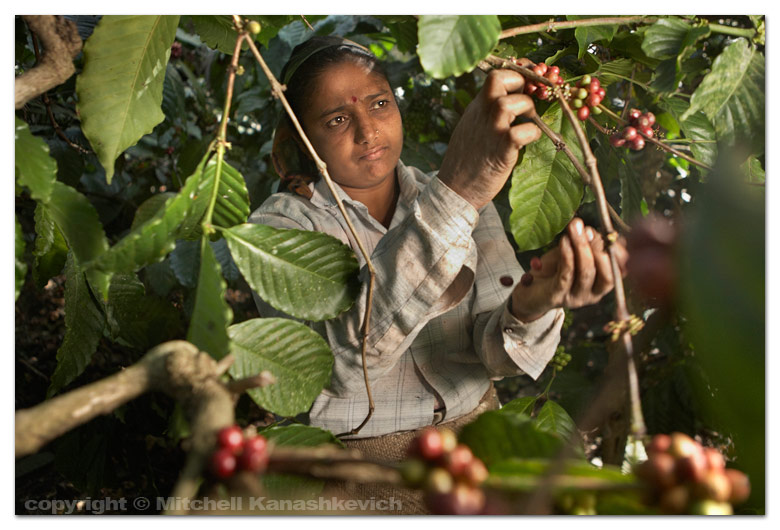 Ready to cry like a child who's been told he's not getting a bicycle after all, I decided instead to go to Vipin's village and give him the Theyyam photos I shot on the night I met him. Vipin was happy to see me and to receive the photos, I couldn't quite match his enthusiasm. But that all changed when he told us that there was a Theyyam performance in his very village. In fact there were two performances that night. These weren't Theyyams aimed at mass audiences, media and tourists, instead I witnessed what was probably as close to Theyyam as it had been hundreds of years ago - raw, sometimes brutal and always full of energy. By late night we had seen a Theyyam performer, possessed by the divine spirit behead four roosters...with his bear teeth, another performer walk through fire and yet another, dance around frantically to some of the most incredible drumming I've heard. We called it a night close to 11pm - real late for rural Kerala. Vipin had been called home a couple of hours before and we were left in the dark, in the middle of nowhere, dependent on our memory to get back. After almost getting lost in the narrow, dark village roads we somehow made it to the main highway that led to Kannur. As we rode the motorcycle back to town, we reflected on the day that pretty much summed up the realities of this life on the road. We were reminded once again that even in the face of the biggest disappointments something amazing could be just around the corner. Knowing that Tanya - my wife was sitting behind me on the bike, ready to face all the obstacles with me also made me realise just how lucky I am.
Ready to cry like a child who's been told he's not getting a bicycle after all, I decided instead to go to Vipin's village and give him the Theyyam photos I shot on the night I met him. Vipin was happy to see me and to receive the photos, I couldn't quite match his enthusiasm. But that all changed when he told us that there was a Theyyam performance in his very village. In fact there were two performances that night. These weren't Theyyams aimed at mass audiences, media and tourists, instead I witnessed what was probably as close to Theyyam as it had been hundreds of years ago - raw, sometimes brutal and always full of energy. By late night we had seen a Theyyam performer, possessed by the divine spirit behead four roosters...with his bear teeth, another performer walk through fire and yet another, dance around frantically to some of the most incredible drumming I've heard. We called it a night close to 11pm - real late for rural Kerala. Vipin had been called home a couple of hours before and we were left in the dark, in the middle of nowhere, dependent on our memory to get back. After almost getting lost in the narrow, dark village roads we somehow made it to the main highway that led to Kannur. As we rode the motorcycle back to town, we reflected on the day that pretty much summed up the realities of this life on the road. We were reminded once again that even in the face of the biggest disappointments something amazing could be just around the corner. Knowing that Tanya - my wife was sitting behind me on the bike, ready to face all the obstacles with me also made me realise just how lucky I am.
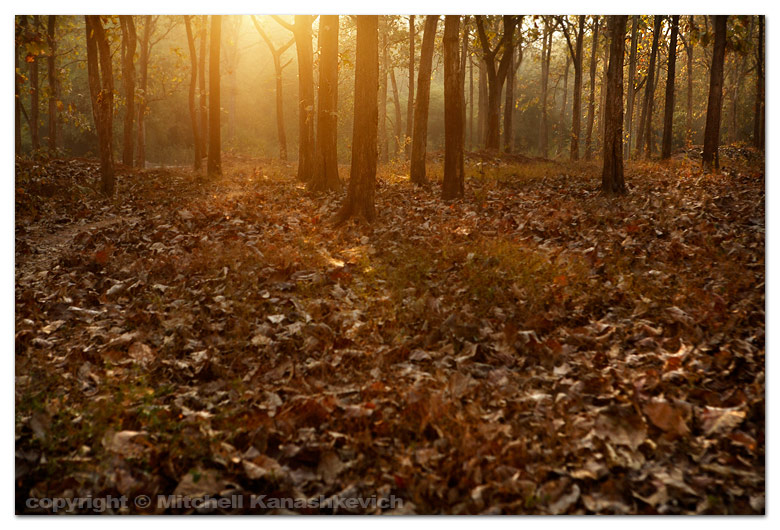 The Theyyam stuff, the heat of coastal Kerala and continuous, hectic rides to the surrounding villages again left us feeling a little drained. We had been contemplating going to Coorg - a hilly region with a cool climate, to refresh for a couple of days, then we'd head back down the coast to Thrissur - one of Kerala's cultural centers. On the map Coorg isn't far from Kannur - 113km. But as always, in India - expect the unexpected. A relatively small patch of the road, known locally as the forest road, was how shall I say - damaged. The damage was so bad that the road looked like it had been bombed continuously for 16 km. I figured that I had traveled on similar roads before, so I didn't make that much of it. BIG mistake! Almost 10km through we started hearing all sorts of noises from our beloved motorcycle. We stopped, I lifted the bike seat and there it was, my worst fear had come true - the motorcycle frame/chasis was broken, snapped right in the middle. To avoid messing things up even more we couldn't continue traveling with all that load and Tanya on the back, and so my poor wife had to walk 6km up a winding, hilly forest road, while I slowly and carefully navigated my way around giant pot holes towards a better road.
The Theyyam stuff, the heat of coastal Kerala and continuous, hectic rides to the surrounding villages again left us feeling a little drained. We had been contemplating going to Coorg - a hilly region with a cool climate, to refresh for a couple of days, then we'd head back down the coast to Thrissur - one of Kerala's cultural centers. On the map Coorg isn't far from Kannur - 113km. But as always, in India - expect the unexpected. A relatively small patch of the road, known locally as the forest road, was how shall I say - damaged. The damage was so bad that the road looked like it had been bombed continuously for 16 km. I figured that I had traveled on similar roads before, so I didn't make that much of it. BIG mistake! Almost 10km through we started hearing all sorts of noises from our beloved motorcycle. We stopped, I lifted the bike seat and there it was, my worst fear had come true - the motorcycle frame/chasis was broken, snapped right in the middle. To avoid messing things up even more we couldn't continue traveling with all that load and Tanya on the back, and so my poor wife had to walk 6km up a winding, hilly forest road, while I slowly and carefully navigated my way around giant pot holes towards a better road.
 We decided to stop for the night at Madikeri - Coorg's biggest town. Our chances of fixing the chasis in this remote region were slim, but Madikeri was our best bet. Again we were facing a very unpleasant situation, but as has happened countless times in India, a stranger came to the rescue. After failed attempts to explain what I need and a few rejections from mechanics and welders who understood, we unexpectedly came across Joe - a catholic Indian man from the coastal city of Cochin. Joe was looking to buy a motor to use for a crop-sorting machine on his spice estate. He came to the same place where we were trying to find out whether our problem can be fixed. After hearing our predicament Joe took it upon himself to help out the guests in his country. The next day his two equally helpful nephews Jeremy and Ronald were involved and although the task became a job of epic proportions (Madikeri is a relatively small town) it was done by the end of the afternoon. It was a little late to head to our next destination and we decided we'd stay another night in Madikeri, that was until Ronald, Joe's nephew called. Ronald found out that I was interested in checking out some tea or coffee plantations/estates and so he invited us over to his estate for the night. We couldn't resist. Another potentially horrible situation had turned in our favor. The next morning we woke up in a mini forest of coffee and pepper bush, as well as some very tall (and apparently expensive) trees. The golden light played it's role in making everything magic. Tanya and I wondered around, appreciated the surroundings and shot a few frames. We expressed our gratitude to our new friends, who saved us and turned a potential disaster into one of the most memorable moments of our journey. Then it was time to move on. Next stop - Bylakuppe - a Tibetan refugee settlement. That's where we are as I type.
We decided to stop for the night at Madikeri - Coorg's biggest town. Our chances of fixing the chasis in this remote region were slim, but Madikeri was our best bet. Again we were facing a very unpleasant situation, but as has happened countless times in India, a stranger came to the rescue. After failed attempts to explain what I need and a few rejections from mechanics and welders who understood, we unexpectedly came across Joe - a catholic Indian man from the coastal city of Cochin. Joe was looking to buy a motor to use for a crop-sorting machine on his spice estate. He came to the same place where we were trying to find out whether our problem can be fixed. After hearing our predicament Joe took it upon himself to help out the guests in his country. The next day his two equally helpful nephews Jeremy and Ronald were involved and although the task became a job of epic proportions (Madikeri is a relatively small town) it was done by the end of the afternoon. It was a little late to head to our next destination and we decided we'd stay another night in Madikeri, that was until Ronald, Joe's nephew called. Ronald found out that I was interested in checking out some tea or coffee plantations/estates and so he invited us over to his estate for the night. We couldn't resist. Another potentially horrible situation had turned in our favor. The next morning we woke up in a mini forest of coffee and pepper bush, as well as some very tall (and apparently expensive) trees. The golden light played it's role in making everything magic. Tanya and I wondered around, appreciated the surroundings and shot a few frames. We expressed our gratitude to our new friends, who saved us and turned a potential disaster into one of the most memorable moments of our journey. Then it was time to move on. Next stop - Bylakuppe - a Tibetan refugee settlement. That's where we are as I type.
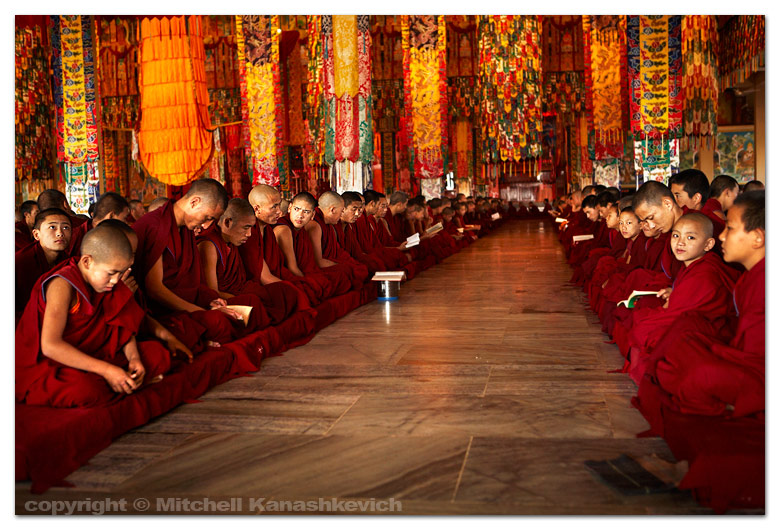 Bylakuppe is a peaceful place, full of maroon robed monks and monasteries. It ain't Himalaya, but there's still something special about it. Monasteries and monks are always photogenic, so we've already spent a few days photographing here. Tomorrow we head off on a little detour, to avoid the dreadful 'Forest Road'. We'll probably end up in Mysore for a few days, then it's on to Wayanad. This cool climate and nature stuff has inspired me to spend some more time up in the hills, in India's forested areas.
Now to the photos. From top to bottom: Monks rushing out after the Morning Prayer, Sera Jey Temple, Bylakuppe. Coffee berry picker at Ronald's estate, Coorg. Morning along the road in Coorg, Kushalnagar region. A mahout washing his elephant at the Dubare Forest Reserve (Forgot to mention we went there. Shot this while standing knee high in water filled with elephant urine and crap ) Bottom: Inside of Sera Jey Temple, Bylakuppe.
Bylakuppe is a peaceful place, full of maroon robed monks and monasteries. It ain't Himalaya, but there's still something special about it. Monasteries and monks are always photogenic, so we've already spent a few days photographing here. Tomorrow we head off on a little detour, to avoid the dreadful 'Forest Road'. We'll probably end up in Mysore for a few days, then it's on to Wayanad. This cool climate and nature stuff has inspired me to spend some more time up in the hills, in India's forested areas.
Now to the photos. From top to bottom: Monks rushing out after the Morning Prayer, Sera Jey Temple, Bylakuppe. Coffee berry picker at Ronald's estate, Coorg. Morning along the road in Coorg, Kushalnagar region. A mahout washing his elephant at the Dubare Forest Reserve (Forgot to mention we went there. Shot this while standing knee high in water filled with elephant urine and crap ) Bottom: Inside of Sera Jey Temple, Bylakuppe.
